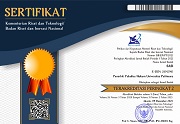Protection of Children's Rights: A Review of Child Marriage Policies in Indonesia, Malaysia, and India
 ), Sonny Dewi Judiasih(2), Deviana Yuanitasari(3), Ramalinggam Rajamanicham(4)
), Sonny Dewi Judiasih(2), Deviana Yuanitasari(3), Ramalinggam Rajamanicham(4)
(1) Faculty of Law, Universitas Padjadjaran, Sumedang, Indonesia

(2) Faculty of Law, Universitas Padjadjaran, Sumedang, Indonesia
(3) Faculty of Law, Universitas Padjadjaran, Sumedang, Indonesia
(4) Faculty of Law, Universiti Kebangsaan Malaysia, Selangor,, Malaysia
 Corresponding Author
Corresponding Author
Abstract
Introduction: Child marriage is a phenomenon that continues and develops, the low knowledge and understanding of the community towards the perception of marriage. Child marriage should not be allowed anywhere in the world as it is a practice that violates general human rights and discriminates against women.
Purposes of the Research: In this research, the author will compare the prevention of child marriage in Indonesia, Malaysia, and India.
Methods of Research: This research uses a normative juridical approach method. Researchers will study and examine the factors that cause child marriage and its legal protection to prevent child protection in Indonesia, Malaysia, and India. This research uses descriptive analytical research specifications by determining the laws and regulations relating to legal theories that are the object of research.
Results of the Research: Indonesia increased the minimum marriage age for both sexes from 18 to 19 with the enactment of Law No. 16 of 2019. Malaysia, meanwhile, sets a maximum marriage age of eighteen. Initiatives to reduce the legal age of marriage, especially for women, have been made in both nations for socio-political and socio-cultural reasons. Alongside these initiatives, India has also ratified several conventions designed to end child marriage. These include the 1976 International Covenant on Civil and Political Rights (ICCPR) and the 1976 International Covenant on Economic, Social, and Cultural Rights (ICESCR), as well as the 1956 Supplementary Convention on the Abolition of Slavery, the Slave Trade, and Institutions and Practices Similar to Slavery.Keywords
DOI
10.47268/sasi.v30i2.2044
Published
2024-06-30
How To Cite
@article{SASI2044,
author = {Hazar Kusmayanti and Sonny Judiasih and Deviana Yuanitasari and Ramalinggam Rajamanicham},
title = {Protection of Children's Rights: A Review of Child Marriage Policies in Indonesia, Malaysia, and India},
journal = {SASI},
volume = {30},
number = {2},
year = {2024},
keywords = {Child Marriage; Indonesia; India; Malaysia.},
abstract = {Introduction: Child marriage is a phenomenon that continues and develops, the low knowledge and understanding of the community towards the perception of marriage. Child marriage should not be allowed anywhere in the world as it is a practice that violates general human rights and discriminates against women. Purposes of the Research: In this research, the author will compare the prevention of child marriage in Indonesia, Malaysia, and India.Methods of Research: This research uses a normative juridical approach method. Researchers will study and examine the factors that cause child marriage and its legal protection to prevent child protection in Indonesia, Malaysia, and India. This research uses descriptive analytical research specifications by determining the laws and regulations relating to legal theories that are the object of research.Results of the Research: Indonesia increased the minimum marriage age for both sexes from 18 to 19 with the enactment of Law No. 16 of 2019. Malaysia, meanwhile, sets a maximum marriage age of eighteen. Initiatives to reduce the legal age of marriage, especially for women, have been made in both nations for socio-political and socio-cultural reasons. Alongside these initiatives, India has also ratified several conventions designed to end child marriage. These include the 1976 International Covenant on Civil and Political Rights (ICCPR) and the 1976 International Covenant on Economic, Social, and Cultural Rights (ICESCR), as well as the 1956 Supplementary Convention on the Abolition of Slavery, the Slave Trade, and Institutions and Practices Similar to Slavery.},
issn = {2614-2961}, pages = {234--248} doi = {10.47268/sasi.v30i2.2044},
url = {https://fhukum.unpatti.ac.id/jurnal/sasi/article/view/2044}
}
Journal Article
Amir, W., H. Wan, A., A. Hakimah, A. Halim, and R. Ismail. “Equity Crowdfunding in Malaysia: Legal and Sharia Challenges.” International Journal of Asian Social Science 9 9, no. 8 (2019): 460–460. https://doi.org/10.18488/ J O U R N A L . 1 . 2 0 19 . 9 8 . 4 5 0 . 4 6 0.
Asmarita. “Peran Unicef Dalam Menangani Kasus Pernikahan Anak Di Bawah Umur Di India.” Jom Fisip 2, no. 2 (2015): 471–85. https://www.childlineindia.org/a/issues/child-marriage.
Barkah, Q., A. Huzaimah, S. Rachmiyatun, Andriyani, and Z Ramdani. “Abandonment of Women’s Rights in Child Marriage; An Islamic Law Perspective.” Al-Ihkam: Jurnal Hukum Dan Pranata Sosial 17, no. 2 (2022): 383–411. https://doi.org/https://doi. org/10.19105/al-Ihkam.v17i2.6725.
Eleanora, Fransiska Novita, and Andang Sari. “Pernikahan Anak Usia Dini Ditinjau Dari Perspektif Perlindungan Anak.” Progresif: Jurnal Hukum 14, no. 1 (2020): 50–63. https://doi.org/10.33019/progresif.v14i1.1485.
Fadilah, Lathifa Nurul, and Haura Atthahara. “Implementasi Kebijakan Pemerintah Terkait Penanganan Pernikahan Di India Dan Jepang.” Jurnal Sains Sosio Humaniora 7, no. 1 (2023): 116–40. https://doi.org/10.22437/Jssh.V7i1.23928.
Forte, C. Lo, M. Plesons, M. Branson, and V Chandra-Mouli. “What Can the Global Movement to End Child Marriage Learn from the Implementation of Other Multi-Sectoral Initiatives?” BMJ Global Health 4, no. 5 (2019): 1–10. 10.1136/bmjgh-2019-001739.
Harvey, C. M., I. Fitz Gerald, J. Sauvarin, G. Binder, and K Humphries-Waa. “Premarital Conception Is a Driver of Child Marriage and Early Union in Selected Southeast Asia and the Pacific Countries.” Journal of Adolescent Health 70, no. 3 (2022): 43–46.
Hassim, M. H., M. Abral, and N. Z Salam. “Spektrum Perkahwinan Kanak-Kanak Di Malaysia: Kajian Perbandingan Antara Enakmen Undang- Undang Keluarga Islam Negeri, Akta Memperbaharui Undang-Undang (Perkahwinan Dan Perceraian) 1976 Dan Konvensyen Antara Bangsa.” E-Jurnal Penyelidikan Dan Inovasi 7, no. 1 (2020): 20–44.
Hossain, Nazli. “Child Marriages.” Journal of the Pakistan Medical Association 73, no. 9 (2023): 1–5. https://doi.org/10.47391/JPMA.23-62.
Judiasih, Sonny Dewi. Perkawinan Bawah Umur Di Indonesia. Bandung: Refika Aditama, 2018.
———. “Sustainable Development Goals and Elimination of Children’s Marriage Practice in Indonesia.” Jurnal Notariil 4, no. 1 (2019): 52–64. http://dx.doi.org/10.22225/jn.3.2.846.75-87.
Kohno, A., M. Dahlui, Nik Farid, N. D., R. Safii, and T. Nakayama. “Why Girls Get Married Early in Sarawak, Malaysia-an Exploratory Qualitative Study.” BMC Women’s Health 20, no. 2 (2020): 1–13. https://doi.org/10.1186/s12905-020-00911-z.
Kohno, Ayako. “{In}-Depth Examination of Issues Surrounding the Reasons for Child Marriage in {Kelantan},(2019). Malaysia: A Qualitative Study.” BMJ Open 9., n.d.
Kusmayanti, Hazar, and Dede Mulyanto. “Problematics Culture Of Child Marriage In Indramayu In A Legal And Cultural Prespective.” Jurnal Pembaharuan Hukum 7, no. 2 (2020): 116–27.
Lilian, G. K., I. A. Nancy, P. A. Odundo, J. O. Akondo, and B Ngaruiya. “Early and Forced Child Marriage on Girls’ Education, in Migori County, Kenya: Constraints, Prospects and Policy.” World Journal of Education 5, no. 4 (2015): 72–80.
Mohd, A., and N. A Kadir. “Minimum Age of Marriage under Islamic Law and the Islamic Family Law (Federal Territories) Act 1984: A Preliminary Study on the Ideal Age of Marriage in Malaysia.” AL-SHAJARAH 24, no. 2 (2019). https://doi.org/10.31436/shajarah.v24i2.945.
Naveed, S., and K. M. Butt. “Causes and Consequences of Child Marriages in South Asia: Pakistan’s Perspective.” A Research Journal of South Asian Studies 30, no. 2 (2015): 161–175.
Nik Wajis, N. R., M. Mochammad Sahid, M. I. Mohamad Yunus, and N. S. Baharli. “Perkahwinan Kanak-Kanak Di Malaysia: Had Umur Minimum Dan Implikasinya.” Malaysian Journal of Syariah and Law 8, no. 2 (2020): 15–30. https://doi.org/10.33102/mjsl.vol8no2.252.
Peletz, M. G. “Are Women Getting (More) Justice? Malaysia’s Sharia Courts in Ethnographic and Historical Perspective.” Law & Society Review 52, no. 3 (2018): 652–684. https://doi.org/10.1111/LASR.12346.
Putri, Alfiandia Vamyla Azhar. “Kendala India Dalam Upaya Mematuhi Konvensi Internasional Terkait Pemenuhan HAM Anak Perempuan Dalam Pemberantasan Pernikahan Anak Di India Melalui Pemberlakuan UU PCMA.” Journal of International Relations 6, no. 3 (2020): 453–62.
“Report Proposal To Amend The Prohibition of Child Marriage Act, 2006 and Other Allied Laws (Report No. 205),” 2008.
S, Kanwal Aslam, Zaheer S, and Shafique K. “Is Spousal Violence Being Vertically Transmitted through Victims?” Findings from the Pakistan Demographic and Health Survey 13 (2015): 10–15.
Saiman, Muhamad Zuhaili Bin, and Fatinah Azami Binti Mahadzir. “Causes and Negative Effects of Child Marriage in Malaysia: A Case Study.” International Journal of Asian Social Science 13, no. 4 (n.d.): 122–32. https://doi.org/10.55493/5007.v13i4.4789.
Santhya, K. G. “Early Marriage and Sexual and Reproductive Health Vulnerabilities of Young Women: A Synthesis of Recent Evidence from Developing Countries.” Current Opinion in Obstetrics and Gynecology 2, no. 35 (2011): 334– 339. https://doi.org/// doi. org / 1 0. 1 0 9 7 / gco.0b013e32834a93d2.
Soekanto, Soerjono, and Sri Mamudji. Penelitian Hukum Normatif Suatu Tujuan Singkat. Depok: Rajawali Pers, 2019.
Suriyani, Hani, Nyulistiowati Suryanti, and Hazar Kusmayanti. “Perlindungan Hukum Bagi Anak Pasca Putusan Dispensasi Kawin Yang Ditolak Berdasarkan Peraturan Perundang-Undangan Terkait.” Hakim 1, no. 4 (2023): 302–16. https://doi.org/10.51903/hakim.v1i4.1476.
Syed Sadat Ali, Dhaded, and Shivprasad Goudar. “The Impact of Nutrition on Child Development at 3 Years in a Rural Community of India.” International Journal of Prevenive Medicine 5, no. 4 (2014): 494–99.
Tahamata, Lucia Charlotta Octovina. “Hak Hidup Anak Dalam Kandungan Di Luar Perkawinan Yang Sah Dalam Pandangan Hak Asasi Manusia.” SASI 2, no. 2 (20015): 57–65.
———. “Perlindungan Hukum Terhadap Pekerja Anak, Kajian Ketentuan United Nations Convention on The Right of The Child.” SASI 24, no. 1 (n.d.): 40–46. https://doi.org/10.47268/sasi.v24i1.117.
Wadjo, Hadibah Zachra. “Pemidanaan Anak Dalam Perspektif Keadilan Restoratif.” SASI 21, no. 2 (2016): 79–90.
Yoshida, Yeni Herliana, Junita Budi Rachman, and Wawan Budi Darmawan. “No Title.” Aliansi : Jurnal Politik, Keamanan Dan Hubungan Internasional 1, no. 3 (2022).
Yuhermansyah, Edi, and Mohd Hakim Bin Mohd Akhir. “Implementasi Batas Umur Pernikahan (Studi Kasus Di Mahkamah Rendah Syari’ah Bukit Mertajam Pulau Pinang).” Samarah 2, no. 2 (n.d.): 486–501. http://dx.doi.org/10.22373/sjhk.v2i2.4749.
Book
Ali, Zainuddin. Metode Penelitian Hukum. Jakarta: Sinar Grafika, 2009.
Thesis, Online/World Wide Web and Others
“Child Marriage in Southern Asia,” n.d. http://reliefweb.int/report/afghanistan/child-marriagesouthern-asia-–-policy-options-action.
Farid, A., I. Chung, S. S. Agha, and R.-C. Yu. “Negotiating Ideations: The Role of State-Led Identity-Making in the Progress of Women’s Rights in Malaysia,” 2022.
Gandhawangi, S. “Lingkungan Kerja Masih Rawan Kekerasan Seksual.” Kompas.Id, n.d. https://www.kompas.id/baca/humaniora/2023/01/25/lingkungan-kerja-masih-rawan-kekerasan-seksual, access 20/03/2024.
Jejeebhoy, SJ. Ending Child Marriage in India, Drivers, and Strategies. New Delhi: UNICHEF, 2019.| Dublin Core | PKP Metadata Items | Metadata for this Document | |
| 1. | Title | Title of document | Protection of Children's Rights: A Review of Child Marriage Policies in Indonesia, Malaysia, and India |
| 2. | Creator | Author's name, affiliation, country |
Hazar Kusmayanti; Faculty of Law, Universitas Padjadjaran, Sumedang; Indonesia  |
| 2. | Creator | Author's name, affiliation, country | Sonny Dewi Judiasih; Faculty of Law, Universitas Padjadjaran, Sumedang; Indonesia |
| 2. | Creator | Author's name, affiliation, country | Deviana Yuanitasari; Faculty of Law, Universitas Padjadjaran, Sumedang; Indonesia |
| 2. | Creator | Author's name, affiliation, country | Ramalinggam Rajamanicham; Faculty of Law, Universiti Kebangsaan Malaysia, Selangor,; Malaysia |
| 3. | Subject | Discipline(s) | |
| 3. | Subject | Keyword(s) | Child Marriage; Indonesia; India; Malaysia. |
| 4. | Description | Abstract | Introduction: Child marriage is a phenomenon that continues and develops, the low knowledge and understanding of the community towards the perception of marriage. Child marriage should not be allowed anywhere in the world as it is a practice that violates general human rights and discriminates against women. Purposes of the Research: In this research, the author will compare the prevention of child marriage in Indonesia, Malaysia, and India.Methods of Research: This research uses a normative juridical approach method. Researchers will study and examine the factors that cause child marriage and its legal protection to prevent child protection in Indonesia, Malaysia, and India. This research uses descriptive analytical research specifications by determining the laws and regulations relating to legal theories that are the object of research.Results of the Research: Indonesia increased the minimum marriage age for both sexes from 18 to 19 with the enactment of Law No. 16 of 2019. Malaysia, meanwhile, sets a maximum marriage age of eighteen. Initiatives to reduce the legal age of marriage, especially for women, have been made in both nations for socio-political and socio-cultural reasons. Alongside these initiatives, India has also ratified several conventions designed to end child marriage. These include the 1976 International Covenant on Civil and Political Rights (ICCPR) and the 1976 International Covenant on Economic, Social, and Cultural Rights (ICESCR), as well as the 1956 Supplementary Convention on the Abolition of Slavery, the Slave Trade, and Institutions and Practices Similar to Slavery. |
| 5. | Publisher | Organizing agency, location | Faculty of Law, Universitas Pattimura |
| 6. | Contributor | Sponsor(s) | |
| 7. | Date | (YYYY-MM-DD) | 2024-06-30 |
| 8. | Type | Status & genre | Peer-reviewed Article |
| 8. | Type | Type | |
| 9. | Format | File format | |
| 10. | Identifier | Uniform Resource Identifier | https://fhukum.unpatti.ac.id/jurnal/sasi/article/view/2044 |
| 10. | Identifier | Digital Object Identifier | 10.47268/sasi.v30i2.2044 |
| 11. | Source | Title; vol., no. (year) | SASI; Volume 30 Issue 2, June 2024 |
| 12. | Language | English=en | en |
| 13. | Relation | Supp. Files | |
| 14. | Coverage | Geo-spatial location, chronological period, research sample (gender, age, etc.) | |
| 15. | Rights | Copyright and permissions | Copyright: Authors who publish their manuscripts in this Journal agree to the following conditions: 1. The copyright in each article belongs to the author, as well as the right to patent. 2. Authors can enter into separate, additional contractual arrangements for the non-exclusive distribution of the journal's published version of the work (e.g., post it to an institutional repository or publish it in a book), with an acknowledgment of its initial publication in this journal. 3. Authors are permitted and encouraged to post their work online (e.g., in institutional repositories or on their website) before and during the submission process, as it can lead to productive exchanges, as well as earlier and greater citation of published work. 4. Authors have the right to self-archiving of the article (Author Self-Archiving Policy)
License: The SASI Journal is disseminated based on the Creative Commons Attribution-NonCommercial 4.0 International license terms. This license allows anyone to copy and redistribute this material in any form or format, compose, modify, and make derivatives of this material for any purpose. You cannot use this material for commercial purposes. You must specify an appropriate name, include a link to the license, and certify that any changes have been made. You can do this in a way that is appropriate but does not imply that the licensor supports you or your use.
|
Copyright (c) 2024 Hazar Kusmayanti, Sonny Dewi Judiasih, Deviana Yuanitasari, Ramalinggam Rajamanicham

This work is licensed under a Creative Commons Attribution-NonCommercial 4.0 International License.

 : 4280 times
: 4280 times Download : 3502 times
Download : 3502 times
















